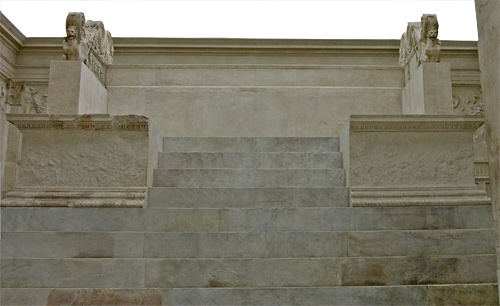
You enter the enclosure, turn right, and walk around the altar, noting the vertical slats on the lower zone of the interior enclosure walls, which suggest a simple fence. Corinthian capitals sit atop pilasters on the sides and corners, and walls of the upper register, marked off by a row of palmettes in low relief, are draped with deeply carved festoons of fruits and leaves suspended between bull's skulls (bucrania) with a libation bowl (patera) hanging above, echoing the motifs of fertility and ritual sacrifice on the exterior of the enclosure walls.
The altar itself sits atop a podium approached by steps; its sides are richly carved with smaller processional scenes referring to the annual sacrifice to Peace performed here on January 30 every year, which Augustus describes in his Res Gestae, the bronze inscription celebrating his achievements that he set up outside his mausoleum:
Ex senatus auctoritate pars praetorum et tribunorum plebi cum consule Q. Lucretio et principibus viris obviam mihi missa est in Campaniam, qui honos ad hoc tempus nemimi praeter me est decretus. Cum ex Hispania Galliaque, rebus in iis provincis prospere gestis, Romam redi, Ti. Nerone P. Quintilio consulibus, aram Pacis Augustae senatus pro reditu meo consacrandam censuit ad campum Martium, in qua magistratus et sacerdotes virginesque Vestales anniversarium sacrificium facere iussit. (Res Gestae Divi Augusti 12)
In the consulship of Tiberius Nero and Publius Quintilius, when I returned to Rome from Spain and Gaul, after affairs had been successfully settled in those provinces, the Senate decreed that an Altar of Augustan Peace should be consecrated in the Campus Martius in honor of my return and ordered that the magistrates and priests and Vestal Virgins perform an annual sacrifice on this altar.
You admire the high wings on either side of the altar, crowned by scrolls of beautifully carved vegetation ending in fanciful winged lions with ibex horns. The small frieze on the south outer wing of the altar depicts the sacrificial procession of priests and victims, including the officiating priests, a sheep, bull and cow. On the north inner wing of the altar, the small frieze shows a procession of the 6 Vestal Virgins, walking according to height and age, headed by the pontifex maximus. As you leave this sacred place, one of the winged lions seems to smile down on you, and you feel blest to be a part of the city which has brought civilization and peace to the world.